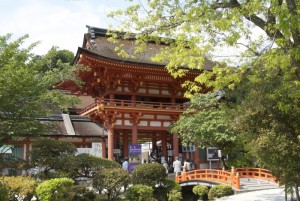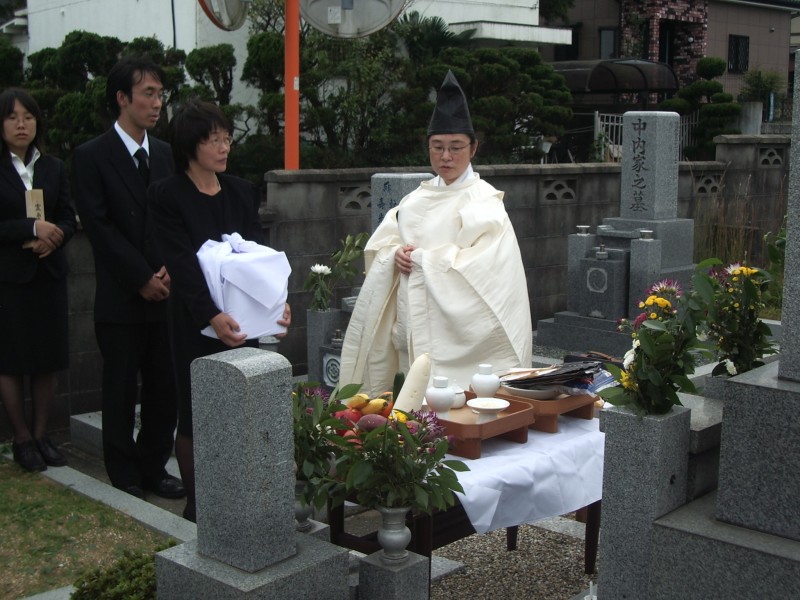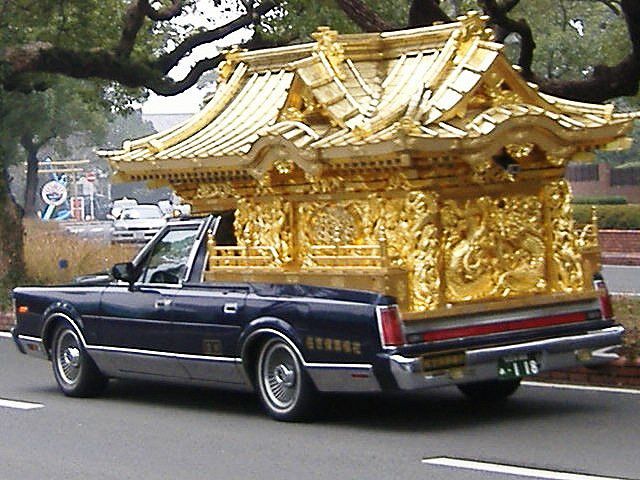This is part of an ongoing series about the Shinto way of death, adapted with permission from an academic article by Elizabeth Kenney. It shows how traditional Shinto arrangements differ from those of the Buddhist funeral. Though the research was carried out in the 1990s and some of the information is dated, the fundamentals still apply. For the original article, see Elizabeth Kenney ‘Shinto mortuary rites in contemporary Japan.’
Impurity
Shinto funerals embody a central tension: a profound aversion to the impurity of death juxtaposed with the necessity of close contact with the corpse. As Robert J. Smith writes, “At the most fundamental level, a Shinto funeral is a contradiction in terms. Shinto abhors pollution in any form — that being virtually its only tenet”.

Kamigamo Shrine, whose priests carry out some ten funerals a year
One way of resolving the contradiction is to redefine impurity. When I asked two priests at Kamigamo Shrine how they could perform funerals, given the Shinto aversion to impurity, they responded by saying that the spirit of the dead is not polluted. In the funeral, they are dealing with the spirit, not the body, of the deceased. As it happens, these priests offered the same explanation Meiji reformers produced to justify the Shinto-style funeral for the emperor: the Emperor’s tamashii is pure and is separate from his body.
According to the priests, Kamigamo Shrine performs about ten funerals a year. This is not a large number for one of the nation’s major shrines. These Kamigamo funerals are performed mostly for the “shrine households” that live near Kamigamo Shrine and have been recognized as prominent patrons of the shrine for generations. Although the priests claim that pollution does not complicate a Shinto funeral, most Japanese people instinctively feel that death and Shinto should be kept apart.
Not all Shinto priests agree with their Kamigamo colleagues. A priest at a small shrine in suburban Osaka refuses to perform Shinto funerals, despite the fact that they are authorized by the Jinja Honchô (the central governing body for most, but not all, Shinto shrines). This priest, well into his eighties, said that people ask him to perform a Shinto funeral three or four times a year, but he always refuses. The reason? “Death is the most impure (kegare) thing.” For him, the matter is clear: Shinto must remain pure, separate from death.

Shinto funerals are not carried out in shrines, but in Buddhist cemeteries and elsewhere
Unlike this old priest, most lay people and many other priests often seem uncomfortable with the very word kegare and offer counter interpretations. One Jinja Honchô official explains that it is not a question of impurity or pollution; it is just that a shrine is a place for festivals and prayers to the kami, so people who have had a death in their family do not feel it is appropriate to go to a shrine.
In a similar fashion, quite a few Japanese people I interviewed resisted the notion of kegare (even telling me that there had never been any such notion in Japan) and preferred the concept of “mourning”. To them, it is a question of grief, respect for the dead, and proper restraint. It may be that the word kegare carries uncomfortable connotations of discrimination or superstition for some modern Japanese people.
When all is said and done, we must see that the polluting power of the corpse is still powerfully felt in Japan. The fact that Shinto funerals are never held within a shrine is testament enough to the force of kegare. A quick look at attitudes toward crematoriums and hearses demonstrates that Japanese people continue to shun the corpse.

The Japanese funeral hearse looks like a gilded temple on wheels
When asked what would be their response to a crematorium being built near their house, 69% of the 1,220 college students polled said they would “oppose it” . It is significant that even among college students, who might be expected to express “modern” views (whether or not they actually subscribe to them), there is a strong desire to avoid close contact with death and its processes. Another indication of the expulsion of the corpse from society is the fact that neighborhoods actually do mount organized protest campaigns against the construction of crematoriums or even funeral halls.
The Japanese hearse is a gorgeous vehicle. An elaborately carved rectangular structure is mounted onto the back of a black car. The hearse looks like a moving temple, with a curved roof and curling golden dragons. Beautiful or not, hearses are not welcome in everyday life. One hearse company is now called K.R. Company. The name of the company was changed five years ago, from Kobe Reikyû Jidôsha (Kobe Hearse). The workers’ families entreated the manager to change the name. Surely this is evidence of a deep uneasiness about death pollution. It is also another example of the magical power of words: avoidance of the taboo word “hearse” offers protection against the negative force of death.
A few years ago, K.R. Company bought a large plot of land and planned to use it as a parking lot for the hearses. The neighbors’ opposition has been so united and effective that the company has not been able to use the land. Understandably, the directors of the company feel beleaguered, since the very neighbors who don’t want a hearse parking lot next door will hire a hearse when they have a death in their family.
Wouldn’t Americans or Europeans also oppose a crematorium in their neighborhood? Yes. I have no doubt that the corpse is, if anything, even more abhorrent in the West. But Western notions of death pollution are a topic for another paper.

Leave a Reply